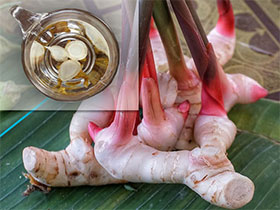Dandelion – a medicinal herb instead of a weed
A miracle herb to drink that not only cures illness, but also preserves and protects our health when consumed regularly. Dandelion regulates digestion, nourishes the liver and gall bladder, helps with rheumatism, dissolves kidney stones, makes pimples and chronic skin conditions disappear and can be used as an all-round tonic.
It is recommended to drink dandelion tea as an infusion or as an intensive brew. For an infusion, boiling water is poured over fresh or dried plant parts. Cover and leave to infuse for ten minutes, then sieve the plant parts. For one cup you need either one fresh dandelion leaf or one to two teaspoons of dried leaves. To make one liter of brew, you need either a few fresh dandelion leaves and two to three dandelion roots or two teaspoons of the dried roots.
The positive influence of dandelion affects all organs involved in digestion. Dandelion increases the secretion of gastric juices, stimulates the appetite and also has an antispasmodic effect. For this reason, dandelion tea, dandelion salad, pressed dandelion juice and the powerful dandelion root extract are used to treat digestive complaints such as flatulence and bloating.
Dandelion also has a choleretic effect. This means that it stimulates bile production in the liver, leads to the excretion of thin bile and improves fat metabolism. Dandelion is therefore the medicinal plant of choice for problems with the liver or gall bladder and is therefore also traditionally used for hepatitis (jaundice), gallstones and liver cirrhosis – under the supervision of a phytotherapeutically experienced alternative practitioner or doctor, of course.
Conventional diuretics (diuretic drugs, also known colloquially as “water tablets”) not only ensure the elimination of water from the body, but also flush out minerals. Dandelion also has a diuretic effect, but at the same time it supplies the body with important minerals, especially potassium, so that the use of dandelion – in contrast to synthetic diuretics – cannot lead to a mineral deficiency. It is therefore used very successfully for urinary tract infections, irritable bladder and other diseases of the urogenital tract.
Conclusion: Dandelion is not only a phenomenal remedy, but also a wonderfully nourishing and prophylactically effective food.
Ginseng – the rejuvenating panacea
In Far Eastern medicine, doctors use ginseng to treat many different ailments. The root is considered a proven tonic that strengthens the immune system, stimulates the metabolism and generally makes the body more resistant to stress and other harmful influences. Ginseng is said to combat fatigue, help against exhaustion and prevent colds. Chinese doctors also recommend the tubers to help people recover after an illness.
Ginseng tea, for example, can be produced in various ways. The most natural variant is the preparation from fresh ginseng. To do this, cut it into the thinnest possible slices with a sharp knife. Bring the water to the boil and leave to cool for at least two minutes. If it is still too hot, the valuable ingredients of the ginseng are destroyed. Then pour the water into a teacup and add about a teaspoon of the ginseng pieces. Leave to infuse for a good five minutes. The longer, the more intense the taste and effect.
There are various laboratory tests that attest to the effects of ginsenosides, as well as other ingredients: Among other things, many of the substances have an anti-inflammatory effect, stimulate the immune system and lower blood sugar levels. Some substances constrict the blood vessels and thus stimulate the circulation.
However, ginseng can also cause side effects. Anyone with diabetes or high blood pressure should only take ginseng preparations after consulting a doctor. Ingredients from the root can alter blood clotting. People who are taking blood-thinning medication should check with their doctor whether they are allowed to use ginseng. Caution: The tuber intensifies the effects that coffee and other caffeinated drinks have on the body.
Galangal – a spicy exotic with healing powers
Originally from Southeast Asia, ‘true galangal’ is a member of the ginger family. Galangal also looks very similar to ginger.
Areas of application in folk medicine are:
- Headache
- Menstrual cramps
- Fever
- Colds
- Loss of appetite
- Nervousness
- Sleep disorders
Apart from the rhizome, the essential oil extracted from it is also used medicinally. It has an antispasmodic, anti-inflammatory and antibacterial effect.
The pungent substances soothe the irritated stomach and dispel nausea (e.g. in the case of travel sickness). Galangal also has a digestive, choleretic and appetizing effect.

Taken as Thai tea, it is not only effective but also very popular. To do this, take two heaped teaspoons of the sliced galangal root and add it to 1/4 liter of boiling water. The whole thing is then boiled for five minutes and the solids are strained off again later. Just three cups a day should help. The tea should be sipped slowly and drunk warm.
In traditional European folk medicine, galangal (e.g. galangal tea or galangal tincture) is primarily used to treat stomach pain, flatulence, abdominal pain, nausea and nausea, loss of appetite and biliary colic. Galangal relieves inflammation
Commission E, an independent scientific expert commission for herbal medicinal products of the Federal Institute for Drugs and Medical Devices (BfArM), has classified galangal as medically relevant and describes it as antispasmodic, antibacterial and also as a prostaglandin synthesis inhibitor.
Prostaglandins are tissue hormones that can trigger inflammation and pain if they get out of balance. As the pungent substances contained in galangal root have been proven to counteract this disharmony, the medicinal plant can have an anti-inflammatory and pain-relieving effect in cases of rheumatism or arthritis, for example.
Ginger – the magical root and its effects
Ginger is very popular because of its unmistakable aroma and its positive effect on health. Ginger is therefore healthy, the effect is positive, side effects are hardly known: The spice and remedy contains healthy essential oils, gingerol, resin and resin acids. Ginger is rich in vitamin C and also contains magnesium, iron, calcium Chemisches Element Ca mit der Ordnungszahl 20, Mineralstoff, der zu den Mengenelementen zählt. Unter den Mineralstoffen ha..., potassium, sodium and phosphorus. The rhizome has an antibacterial effect and can therefore contribute to a healthy intestinal flora.
To make a strong ginger drink, cut off 1.5 cm of ginger root, peel it and then grate it. Place the ginger in a large cup or jug and pour hot, boiled water over it. Then leave to infuse for about ten minutes. The ginger pulp can also be drunk, as it naturally also contains some active ingredients. In combination with good honey, a delicious healing drink.
Ginger has a virusstatic effect, i.e. it inhibits the multiplication of viruses. It is also antiemetic, i.e. it prevents vomiting. The pungent substances in particular also stimulate blood flow and circulation, both of which are usually also healthy. Ginger also aids digestion and increases the production of gastric juice, saliva and bile.
It stimulates the metabolism, promotes fat digestion and stomach acid production. These are also good approaches for a diet. Test subjects who drink a glass of ginger water with their meal also reportedly eat less than others. At least that’s what some studies claim.
In conclusion, dandelion, ginseng, galangal and ginger, when consumed as natural infusions, have a positive effect on general health.
